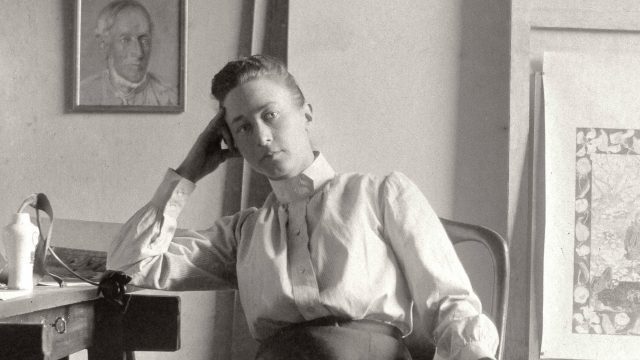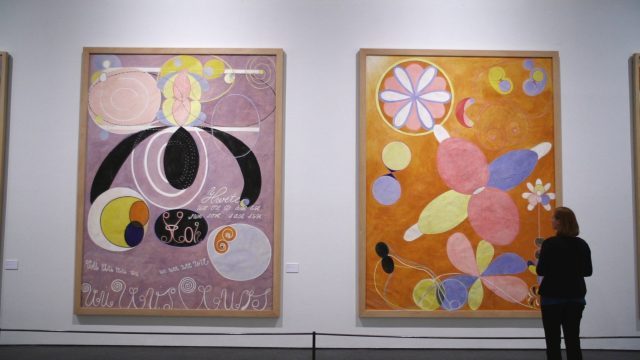
Beyond the Visible profiles the life and work of master abstractionist Hilma af Klint
BEYOND THE VISIBLE: HILMA AF KLINT (Halina Dyrschka, 2019)
Opens virtually April 17, $12 (good for one-week pass)
Live Q&A on April 18 at 3:00
kinonow.com
zeitgeistfilms.com
In 2013, a new hero burst onto the art scene, despite being dead for nearly seventy years. First came “Hilma af Klint — A Pioneer of Abstraction,” by all accounts an eye-opening show that toured Europe, followed five years later by the smash Guggenheim exhibit “Hilma af Klint: Paintings for the Future,” which propelled the extraordinary work of the Swedish abstractionist into the mainstream. I fondly remember making my way through the show, mouth agape at the many wonders I was seeing. German director Halina Dyrschka continues the celebration of this previously little-known painter in the documentary Beyond the Visible — Hilma af Klint, which will be available for streaming April 17 through Kino Marquee in association with BAM in Brooklyn and Laemmle Monica Film Center in Los Angeles. Dyrschka and Guggenheim assistant curator David Max Horowitz will participate in a Zoom Q&A with BAM on April 18 at 3:00.
In her debut full-length film, Dyrschka digs deep into who af Klint was, what inspired her unique achievements, and why she had been overlooked until the 2010s. “Now we have a real scandal,” German art critic and af Klint biographer Julia Voss says. “Suddenly, more than fifty years after history was written, completely out of the blue, at least for the general public, we discover this woman who painted abstract works before Kandinsky, creating this huge oeuvre, fully independently, and by a kind of miracle it’s all stayed together. It’s like finding a time capsule in Sweden. And now we have to ask: How should we integrate it?”
Born in Stockholm in 1862, af Klint incorporated physics, mathematics, the natural world, and spiritualism into her paintings, abstract canvases that predated Wassily Kandinsky and Piet Mondrian, who both, like af Klint, died in 1944. She didn’t exhibit any of her work until 1906, and after that only sparingly. Upon her death, her estate was not permitted to show anything for twenty years; her first posthumous exhibition was held in LA in 1986.
“We are not here forever,” Dyrschka narrates early in the film. “So it is not at all astonishing that someone once wondered about what it means to be in the world and how everything fits together — and came up with a huge answer. The strange thing is I only found out about it more than one hundred years later. Art history has to be rewritten.” Among the others lobbying for af Klint’s ascension into the art canon are artists Josiah McEhleny and Monika von Rosen, novelist Anna Laestadius Larsson, art historians Ernst Peter Fischer and Anna Maria Bernitz, Eva-Lena Bengtsson of the Royal Academy of Fine Arts in Stockholm, collector Valeria Napoleone, and gallerist Ceri Hand, offering different perspectives of the value and legacy of her her work. Lending more personal insight are Ulla af Klint, the widow of Hilma’s nephew Erik (from a 2001 interview); Johan af Klint, Ulla’s son, who ran the Hilma af Klint Foundation, which oversees the artist’s 1,500 paintings and 26,000 pages in notebooks; and Marie Cassel and Brigitta Giertta, descendants of two of Hilma’s closest friends. Together they paint a compelling portrait of the iconoclastic af Klint, who filled her work with cutting-edge and fringe philosophy and science. But you don’t have to agree with her offbeat world view to fall in love with her gorgeous canvases, many of which are displayed in the film.

The extraordinary canvases of Swedish artist Hilma af Klint are on view in Beyond the Visible
Curator Iris Müller-Westermann explains, “Never in her lifetime did she put any of her abstract work on show. Hilma af Klint’s project was something much grander than what we today call ‘art.’ It was all about seeing the world we live in in a larger context, to understand who we really are in a cosmic perspective.”
Cinematographers Alicja Pahl and Luana Knipfer often let the camera linger on peaceful shots of water, flowers, the sky, and other natural elements that morph into Klint’s paintings and reenactments of af Klint working on a large-scale painting on the floor of her studio. Petra van der Voort reads excerpts from af Klint’s writings in voice-over, narrating from books that we can follow along with, zooming in on her penmanship, while Damian Scholl supplies a wide-ranging, eclectic score.
“She was well educated, she had a mind of her own, and she painted like nobody else,” Johan af Klint says. McElheny points out, “In order to tell the history of abstraction now, you have to rewrite it.” Beyond the Visible confirms that it’s time for a new history.